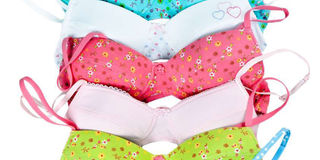Can’t breath? Wrong bra size could be the reason

Doctors have now attributed wearing the wrong bra size to some of the medical symptoms women find themselves with. PHOTO | FOTOSEARCH
Severe pain in her chest, neck, shoulders and back, and difficulty breathing were her symptoms before she found herself in hospital.
Angela Atieno was at work when she felt sharp pain in her muscles. After some time, she couldn’t breath. She thought the previous day’s work of preparing her son’s birthday party had caused the muscle ache.
She was taken to hospital and a nurse who was performing first aid noticed her bra was too tight. The nurse identified that as the first possible explanation to her symptoms, but went ahead with other tests. “I remember all the tests were negative and the pain reduced when they removed the bra,” said Atieno.
Doctors have now attributed wearing the wrong bra size to some of the medical symptoms women find themselves with.
The nurse advised Atieno to be choosing the right bra size and be choosing moments in the day to stay without a bra. “The first thing I do when I get home is to remove my bra. I can’t stand bras. They make me very uncomfortable. Also, I prefer the exercise bras to these modern ones,” said the nurse.
Atieno has now learnt her lesson. “Putting on the wrong bra size is the most uncomfortable thing. It can mess up your day if you’re not careful. You cannot work because the whole body aches,” she said.
Bra size is difficult to measure. The accuracy of bra measurements is determined by breathing, posture and your body size.
Researchers suggest that bra-size measurement should take place over a well-fitted, unpadded and thin bra. But, most women are likely to be fitted in a shop while wearing their own bra, regardless of whether or not it fits well.
BREAST CANCER
A study that assessed the bra fit of women wanting breast reduction surgery revealed that more than 80 per cent of women are wearing the wrong bra size. “Women have different breast sizes and the sizes can easily change for a number of reasons, including losing or gaining weight, but most women stick to their sizes for years regardless of the change,” says bra fit expert and technical manager Julia Mercer.
Some women prefer putting on tight bras with the notion that it gives a fuller and more enhanced bust not knowing they are inviting problems.
But according to a dermatologist, Dr Dina Keen, tight clothing, including bras are known to cause cysts. “Sacs containing semi-fluid tissues can form on the skin as a result of wearing an overly tight bra. This can results in cysts under the skin,” said Dr Keen who works with eMediHealth. “Occlusion of pores which may occur from pressure or tight garments could potentially cause the formation of cysts.”
A recent study conducted at Harvard University linked wearing tight bras to breast cancer. “When one puts on a very tight bra, it restricts blood circulation and can also impair the lymph tissues delivering less oxygen and fewer nutrients to the cells, while waste products are not flushed away,” said the study.
According to the study, middle-class women are at a higher risk of breast cancer since they work for longer hours and those who wear bras for more than 12 hours a day and even sleep in them.
“Extremely tight bras restrict the lymph flow to one's breasts. Normally, the lymph fluid washes out waste materials and other toxins away from the breasts, but bras inhibit this action, so toxins can start to accumulate in the breast, and that can help cancer to develop,” showed the study.
It also revealed that since lymphatic vessels are very thin, they are extremely sensitive to pressure and are easily compressed.
PADDED BRAS
Explaining how one would know that they are putting on the wrong bra, Mercer said one realised this if the breasts are coming out of the cup. This means that either the under band is too big or the cup is too small.
“If you want to check whether your bra is well-fitting, after putting it on, lift up your arms and twist the body, the bra, and the breasts should remain in their position. It should fit firmly, but not too tight,” she said. The cups should cover all the breast tissue.
“Another issue is the straps. They should not be tight. They are not made to support the bust, but the cups. One should fit two fingers on top of each other underneath. In order to know whether the bra is supporting you, slide the straps down to see if the cups are still doing their job,” she said.
If the cups are too big, this means there isn’t enough support and a new bra is needed.
She advised that for women to know their right sizes, they need to try them out before buying, but not on top of clothing. “Your bra should fit in just right and shouldn’t be too tight or too loose,” she said.
For the padded bras, Mercer advised that the breasts should fill in the cups completely. If they are spilling over, it means the bra is too tight. If there is a gap between breasts and the cups, the bra is too loose.
“Take a look at your back, if you see the bulges on the sides, opt for a bigger size. If you are trying an underwired bra, the underwire should lay flat under your breasts and the centrepiece should stay flat on your breastbone,” she added.



